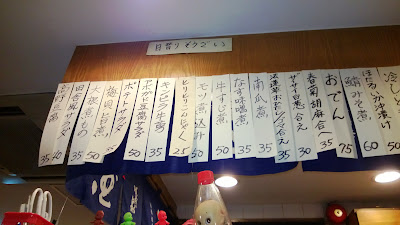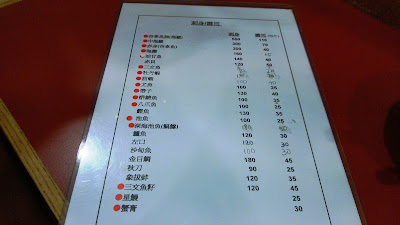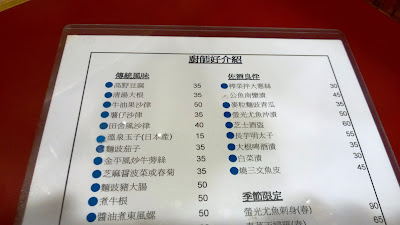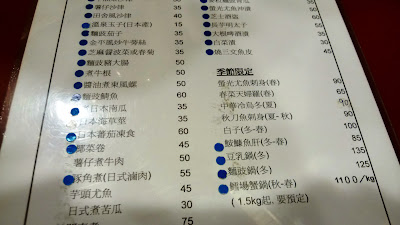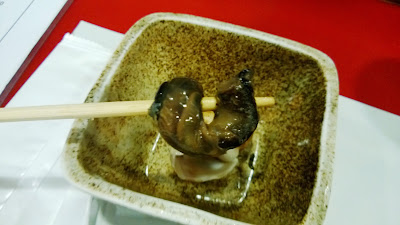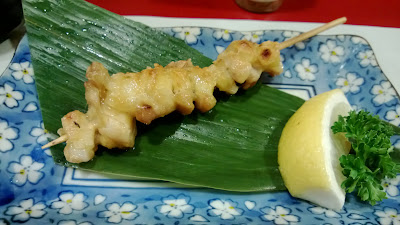Izakaya - a way to unwind and relax
Izakaya 居酒屋 is a truly wonderful type of Japanese dining establishment. Much like dai pai dong, it is extremely accessible, personable, and somewhat affordable. It's all about the atmosphere, good food, and good drink, and with the right company it is an unbeatable experience. You go in times of happiness, or even in times of sorrow. It was for the longest time, the Japanese salary man's last stop before going back home to an even more stressed out wife and to his kids (unless he stopped by the cat house on the way home). But nowadays, it is also the working person's meal of choice, perhaps a place to bond with coworkers, and also to vent about upper management, or to gossip about others in the company. And izakaya is not just for men anymore.
Ishiyama 石山 is tucked away on Lockhart Road, not too far away from the Wanchai side, but still considered Causeway Bay. When you walk up, you might see some "members only" sign, but anyone can come in. The counter seats are probably where you want to be, and maybe the best is in front of the chef. Looking up, there are rectangular sheets of the various dishes (many of which are also on the Chinese only menu)
Lots of varieties to choose from
And just like most great izakayas, there are a variety of small dishes to choose from, as well as grilled items (yakimono), fried items (agemono), the requisite sashimi section (no sushi here), and some yakitori...but honestly this is not a strong point of the restaurant since I they do not appear to use Japanese charcoal (binchotan)
Decent beverage selection too.
Even if you choose not to drink here, the food and service are very good. You may find some Japanese expats here, in addition to local Cantonese speaking customers.
Menu in Chinese, no surprises here
Chef's recommended dishes, I highly recommend focusing your ordering based on these as well!
Skewers
Grilled items
Let's get started.
Koya Tofu 高野豆腐
This is a rather interesting preparation. 高野豆腐 (Koya tofu) they say was discovered by a monk in Japan who left a piece of tofu outside the temple a little too long....it froze and rather than wasting it, he took it back inside and tried cooking it. To his surprise, the lower temperature compressed the interior, and changed the molecular chemistry. The tofu was a lot more firm, compacted, and soaked up flavor like a sponge, that apparently became the basis for making tofu have the texture of meat (well you can interpret it any way you like). For me personally, I very much enjoyed this texture. This is one of the simpler things in Japanese cooking and ingredients, and perhaps it is not widely appreciated globally, let alone in Hong Kong. For a version that is not served in warm dashi or some other broth, this is simplicity that works.
Koya tofu is different from frozen tofu used in places like Little Sheep Mongolian Pot, because Koya Tofu adds another process of drying after the freezing.
Ni-daikon, or simmered daikon in dashi. This piece was very smooth and had no rough fibers in it. Japanese mustard on the side provided a nice counterpoint to the light sweetness, and the dashi was good.
A very textbook but delicious rendition of monkfish liver. If you have more than 2 people in your party, this would not be enough. The addition of thin slices of Japanese cucumber (kyuri) added a nice crunch to the dish, along with seaweed and momiji oroshi.
I was curious about their onsen tamago (warm springs egg) so gave that a shot. At HK$10 this was a no brainer. Unfortunately it was served cold to my dismay, and pretty much a textbook soft boiled egg in dashi with hon wasabi on top.
This onsen tamago is nothing like those great hanjuku tamago simmered eggs at your favorite ramen shop. Certainly interesting, but at least did not hurt so much :-)
There is a Japanese dish of stewed simmered sinews (Gyu Suji Nikomi), and theoretically it is supposed to be beef tendon in some soy sauce mirin sugar base. In the USA this dish would be a mix of fatty beef or tiny pieces of fatty short rib or shank that has some tendons in it. Here this is the true Hong Kong rendition, because we love beef tendons in their purest form so much. This was pretty glorious, a Japanese approach, to no nonsense beef tendons. This rendition would be a complete shocker in the USA. Perfect on cold nights.
This was one of the best side dishes hands down. Japanese "baigai" which look like the spiral babylons 東風螺 found in fish markets (particularly in Southern Hong Kong like Ap Lei Chau). Here this dish is served cold, in a richer marinade that was also likely soy sauce mirin maybe dashi and of course sugar.
The shellfish was simmered long enough that the marinade penetrated into and around the shell, and the meat was surprisingly tender (and juicy). The perfect companion with sake (or soju). I could have polished off a few more of these easy, but had to restrain myself.
Pictured above are standard yakitori (thigh with soy sauce) and nankotsu (soft knee bone cartilage). Not bad for an izakaya that does not specialize in yakitori (and likely not grilled with binchotan/charcoal due to the lack of intense grill marks). Obviously not their strength here.
Overall a very pleasing meal and significantly cheaper than a mid to higher end sushi restaurant in Causeway Bay. $300 to $400 ish a person which is not reasonable, and comparable to many izakaya restaurants in San Francisco Bay Area (and in some cases far superior depending on the dish).
Ishiyama 石山
銅鑼灣駱克道513-515號永勝大廈1樓
1/F, 513-515 Lockhart Road, Causeway Bay

